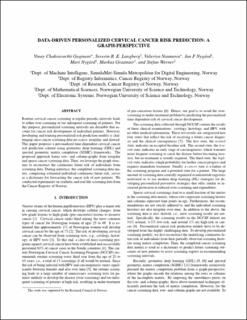| dc.contributor.author | Gogineni, Vinay Chakravarthi | |
| dc.contributor.author | Langberg, Geir Severin Rakh Elvatun | |
| dc.contributor.author | Naumova, Valeriya | |
| dc.contributor.author | Nygård, Jan | |
| dc.contributor.author | Nygård, Marie | |
| dc.contributor.author | Grasmair, Markus | |
| dc.contributor.author | Werner, Stefan | |
| dc.date.accessioned | 2022-03-28T14:31:32Z | |
| dc.date.available | 2022-03-28T14:31:32Z | |
| dc.date.created | 2022-01-12T16:51:51Z | |
| dc.date.issued | 2021 | |
| dc.identifier.isbn | 978-1-7281-5767-2 | |
| dc.identifier.uri | https://hdl.handle.net/11250/2988120 | |
| dc.description.abstract | Routine cervical cancer screening at regular periodic intervals leads to either over-screening or too infrequent screening of patients. For this purpose, personalized screening intervals are desirable that account for cancer risk development of individual patients. However, developing and training personalized risk prediction models is challenging since cancer screening data are scarce, irregular, and skewed. This paper proposes a personalized time-dependent cervical cancer risk prediction scheme using geometric deep learning (GDL) and spectral geometric matrix completion (SGMC) frameworks. The proposed approach learns row- and column-graphs from irregular and sparse cancer screening data. Then, we leverage the graph structure to reconstruct the continuous latent risk of individuals from screening data. During inference, the completed screening data matrix, comprising estimated individual continuous latent risk, serves as a dictionary for forecasting the cancer risk of new patients. We conducted experiments on synthetic and real-life screening data from the Cancer Registry of Norway. | en_US |
| dc.language.iso | eng | en_US |
| dc.publisher | Institute of Electrical and Electronics Engineers (IEEE) | en_US |
| dc.relation.ispartof | 2021 IEEE Statistical Signal Processing Workshop (SSP) | |
| dc.title | Data-Driven Personalized Cervical Cancer Risk Prediction: A Graph-Perspective | en_US |
| dc.type | Chapter | en_US |
| dc.description.version | acceptedVersion | en_US |
| dc.rights.holder | © IEEE. Personal use of this material is permitted. Permission from IEEE must be obtained for all other uses, in any current or future media, including reprinting/republishing this material for advertising or promotional purposes, creating new collective works, for resale or redistribution to servers or lists, or reuse of any copyrighted component of this work in other works. | en_US |
| dc.identifier.doi | 10.1109/SSP49050.2021.9513824 | |
| dc.identifier.cristin | 1979812 | |
| dc.relation.project | Norges forskningsråd: 274717 | en_US |
| cristin.ispublished | true | |
| cristin.fulltext | postprint | |
| cristin.qualitycode | 1 | |
